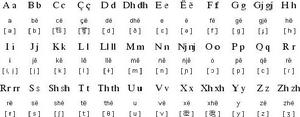
Albanian(阿爾巴尼亞語)
Albanian is an Indo-European language which forms its own branch in the Indo-European family and has no close relatives. There are two main dialects of Albanian: Tosk, which is spokenby about 3 million people in southern Albania, Turkey,Greeceand Italy; and Gheg, which is spoken by about 2.8 million people in Serbia and Montenegro, Kosovo, Macedonia, northern Albania and Bulgaria. The dialects are more or less mutually intelligible and Tosk is the official language of Albania, and one of the official languages of Kosovo and Macedonia.Albanian has been written with various alphabet since the 15th century. Originally the Tosk dialect was written with the Greek alphabet, while the Gheg dialect was written with the Latin alphabet. They have both also been written with the Turkish version of the Arabic alphabet. The Latin alphabet for Albanian was standardised in 1909, and a unified literary version of Albanian, based on the Tosk dialect, was established in 1972.
Albanian has also been written with two other scripts: Elbasan and Beitha Kukju, local inventions which appeared during the 18th and 19th centuries but were not widely used
1>Elbasan script
The Elbasan script was invented around the middle of the 18th century and named after the city of Elbasan in central Albania where it was used
2>Beitha Kukju script
The Beitha Kukju script was invented in about 1840 and was named after its inventor.
3>Latin alphabet for Albanian
Sample text (Tosk)
Të gjithë njerëzit lindin të lirë dhe të barabartë në dinjitet dhe në të drejta. Ata kanë arsye dhe ndërgjegje dhe duhet të sillen ndaj njëri tjetrit me frymë vëllazërimi.Translation
All human beings are born free and equal in dignity and rights. They are endowed with reason and conscience and should act towards one another in a spirit of brotherhood.
